It looks like you're using an Ad Blocker.
Please white-list or disable AboveTopSecret.com in your ad-blocking tool.
Thank you.
Some features of ATS will be disabled while you continue to use an ad-blocker.
share:
a reply to: AstroStar
It's the date palm of Enki, a bird of Heaven An-zu possibly Cygnus which is close to the Field Constellation/Pegasus square and the serpent possibly Cetus, the date palm motif could also be related to the eight legged spider which could also represent Canis Major at that early Dilmun period as well as the eight pointed star/floret, the crescent beneath the star an asterism of Canis Major, later periods Sirius was the arrow star of a bow still relating thus to liner projection.
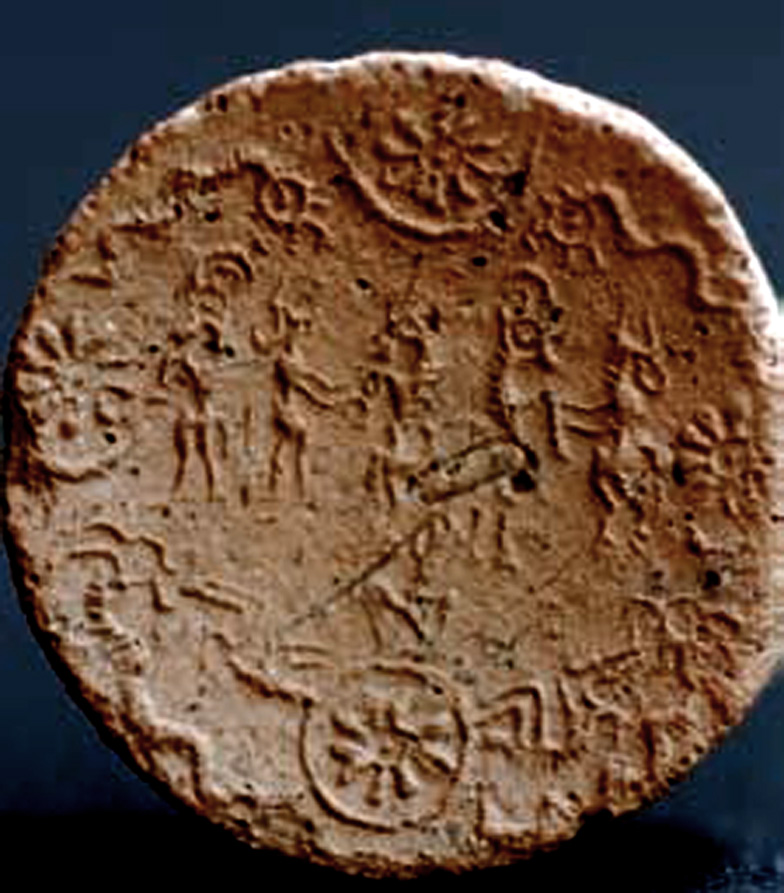
The spider Goddess Uttu as Canis Major saw Enki ploughing through generations of daughters to arrive at the birth of Uttu from whom eight Deities were born through eight plants, that's Enki as a God of evolutionary generations and development, so Sirius represented such principles at that time, and the relationship between plants and living creatures is established, the axiom of Enki relates to raising and establishing the standard.
Enki and Ninhursag
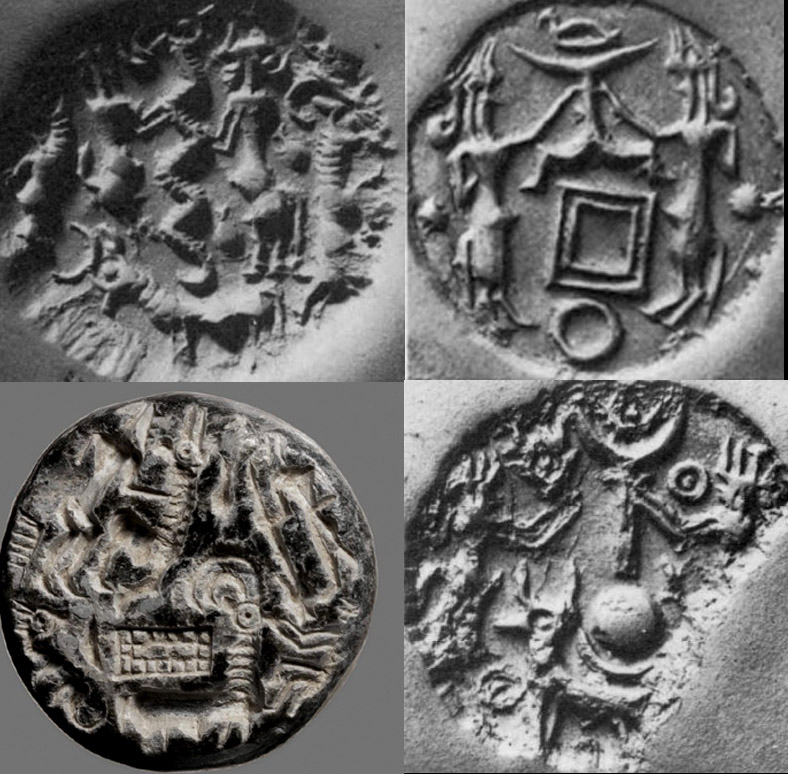
The dot in the circle as used for the eyes is a Sun symbol but it is also applicable to Sirius as the brightest star as still related to light, i don't think this directly relates to the Eye of Providence which i think derives from the Planet Mercury seen as an Eye of Re though the principle is the same in terms of inner illumination and consciousness.
It's the date palm of Enki, a bird of Heaven An-zu possibly Cygnus which is close to the Field Constellation/Pegasus square and the serpent possibly Cetus, the date palm motif could also be related to the eight legged spider which could also represent Canis Major at that early Dilmun period as well as the eight pointed star/floret, the crescent beneath the star an asterism of Canis Major, later periods Sirius was the arrow star of a bow still relating thus to liner projection.

The spider Goddess Uttu as Canis Major saw Enki ploughing through generations of daughters to arrive at the birth of Uttu from whom eight Deities were born through eight plants, that's Enki as a God of evolutionary generations and development, so Sirius represented such principles at that time, and the relationship between plants and living creatures is established, the axiom of Enki relates to raising and establishing the standard.
Enki and Ninhursag

The dot in the circle as used for the eyes is a Sun symbol but it is also applicable to Sirius as the brightest star as still related to light, i don't think this directly relates to the Eye of Providence which i think derives from the Planet Mercury seen as an Eye of Re though the principle is the same in terms of inner illumination and consciousness.
edit on 15-1-2022 by Madrusa because: (no reason given)
a reply to: Madrusa
The handbag type shapes that are at the top of stone blocks below have always confused me about Gobekli Tepe, could it be rising Sun glyphs?
www.ancient-origins.net...
The handbag type shapes that are at the top of stone blocks below have always confused me about Gobekli Tepe, could it be rising Sun glyphs?
www.ancient-origins.net...
a reply to: AstroStar
It's more likely to be the handbag of the Goddess Inara called the Kursa, a hunting bag, which could be held to contain a sampling of all beasts, if you look closely there are little beasts seen in conjunction.
A Kursa on the Eya tree.
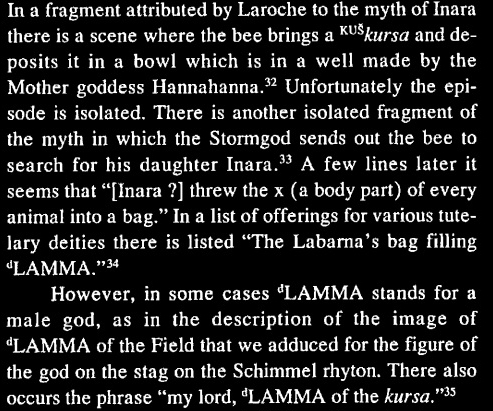
The best examples are from later Jiroft and appear to relate closely to a Lord of Beasts as related to hunting, the brother of Inara in Hattic myth Telepinu.
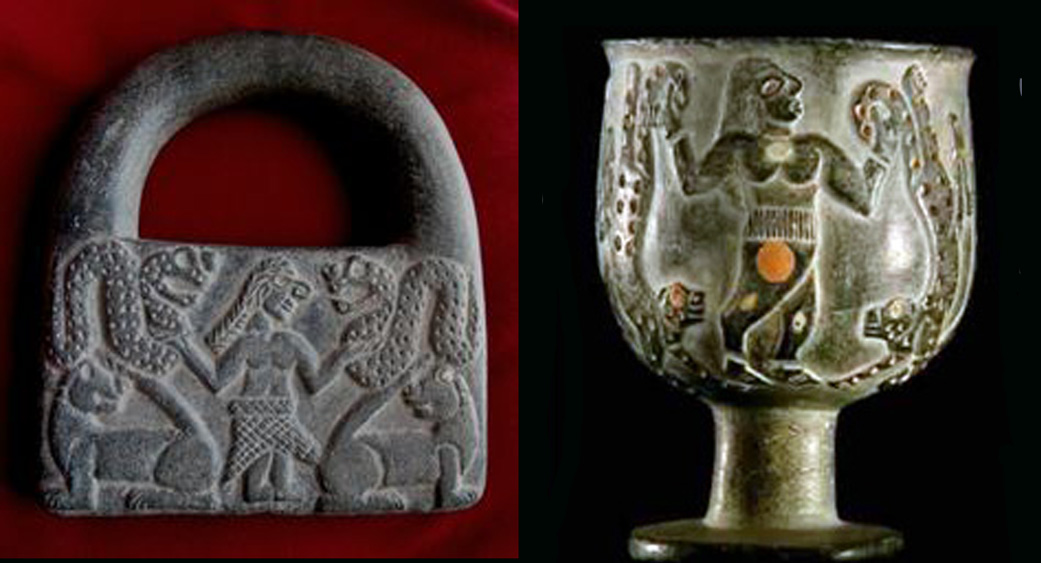
There is an astral connection as Constellations can be seen mirrored on these, thus the handle relates to the arc of the skies, this will also relate to their importance as grave objects, the rising and the setting transference across horizons
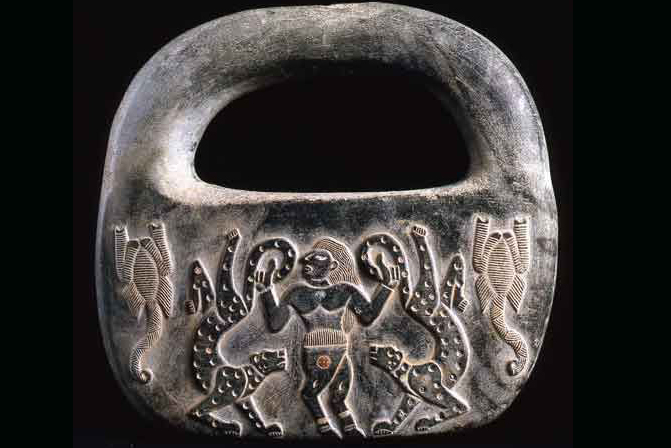
Thus the Kursa could also be said to relate to the world and the three levels of existence, but it could also represent three worlds in terms of three ages in the bag as it were, perhaps that is why three are carved at Gobekli Tepe, whatever the case this is carried over from Mesolithic tradition.
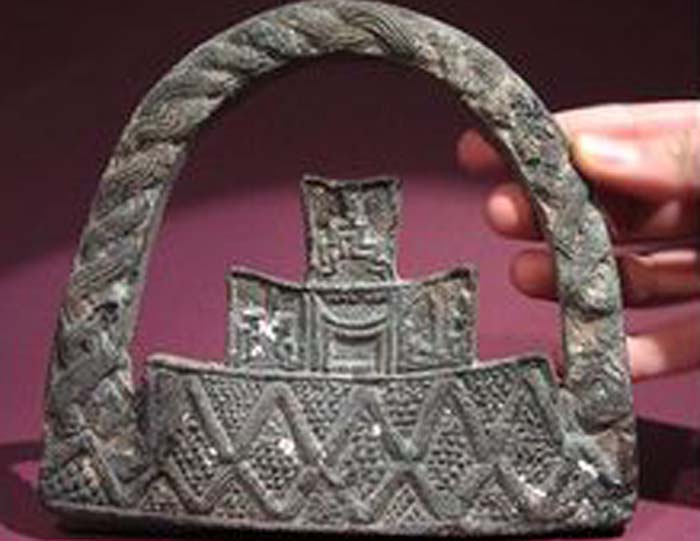
It's more likely to be the handbag of the Goddess Inara called the Kursa, a hunting bag, which could be held to contain a sampling of all beasts, if you look closely there are little beasts seen in conjunction.
In the festivals, Inara is reproduced on several occasions as having the features of the goddess of the hunt, and also as the mistress of the animals. In the KI.LAM. Festival - a three-day festival which was celebrated in Hattusa – the leopard, the deer, and the boar are offered as the animals of the goddess. From the temple of the goddess, Inara is featured in texts from the Old Kingdom with a procession of these animals on the first day. Like other tutelary gods of nature Inara could be worshipped as the figure of a kursa.
A Kursa on the Eya tree.

The best examples are from later Jiroft and appear to relate closely to a Lord of Beasts as related to hunting, the brother of Inara in Hattic myth Telepinu.

There is an astral connection as Constellations can be seen mirrored on these, thus the handle relates to the arc of the skies, this will also relate to their importance as grave objects, the rising and the setting transference across horizons

Thus the Kursa could also be said to relate to the world and the three levels of existence, but it could also represent three worlds in terms of three ages in the bag as it were, perhaps that is why three are carved at Gobekli Tepe, whatever the case this is carried over from Mesolithic tradition.

edit on 15-1-2022 by Madrusa because: (no reason given)
a reply to: Madrusa
Thanks Madrusa,
I'm fine on Egyptian and Greek legends, but obviously not all legends, some beliefs around the world can think Sirius is where souls go, even native American Star lore think of it as a dog guarding souls!
www.wwu.edu...
I'll back in a few days.
Thanks Madrusa,
I'm fine on Egyptian and Greek legends, but obviously not all legends, some beliefs around the world can think Sirius is where souls go, even native American Star lore think of it as a dog guarding souls!
www.wwu.edu...
I'll back in a few days.
originally posted by: Madrusa
a reply to: AstroStar
It's more likely to be the handbag of the Goddess Inara called the Kursa, a hunting bag, which could be held to contain a sampling of all beasts, if you look closely there are little beasts seen in conjunction.
Again, it's quite a stretch to connect Göbekli Tepe to the Hurrians. I mean, there's a 7,000 year gap there.
A bag is a bag though. At Göbekli Tepe, the bags could as easily represent their own hunting bags conveying the surplus of game, or grain bags, showing how fruitful the area was, or just the bags they used to carry the dirt to bury the place - which they did every 15 to 25 years.
Harte
originally posted by: AstroStar
a reply to: Madrusa
Thanks Madrusa,
I'm fine on Egyptian and Greek legends, but obviously not all legends, some beliefs around the world can think Sirius is where souls go, even native American Star lore think of it as a dog guarding souls!
www.wwu.edu...
I was unable to confirm the legend from that website. There's so many BS indigenous sites out there, and BS indigenous legends, that I always check.
Harte
a reply to: Harte
The Hittite-Hurrian texts are the closest you'll get to understanding, but also the Hittites were great restorers and maintainers of tradition hence the reason they collected and wrote down the myths and rituals of greater Anatolian tradition, they likely also best preserved the cultic associations of constructing with pillars.
You shall build for eternity
It has to be considered the extent cultic practises of those sites had continued in some form even into the historic period.
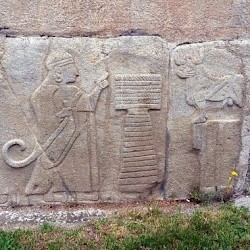
The Hittite-Hurrian texts are the closest you'll get to understanding, but also the Hittites were great restorers and maintainers of tradition hence the reason they collected and wrote down the myths and rituals of greater Anatolian tradition, they likely also best preserved the cultic associations of constructing with pillars.
In front of [the pillar where] the owner of the house is sitti[ng, to] (this) pillar they do not sacrifice (any sheep). Bu[t] to the pillars (sg.) which are on the right and left (side of the owner of the house), to those they sacrifice (sheep) in three different places.
Each time, however, they s[ac]rifice one sheep.In front of the altar, he (the owner of the house) pours beer (and) wine after the blood (offering). In front of each of the two pillars they libate three times. They place the raw meat (of the sacrificed sheep), the breasts, shoulders, heads, and feet, in front of the altar.
The breast, shoulders, heads, (and) feet they place in front of those t[wo] pillars, to (or for) which (animals) have been slaughtered. Afterward he libates beer (and) wine three times before the altar.
He (now) libates three times before each of the three pillars. He makes the rounds 14 times (around the pillars?). [They] play the small IStar-instrument.
You shall build for eternity
There are ample archaeological remains from the Early Bronze Age which illustrate the early Hattic building tradition. Needless to say, the Hittites
inherited this tradition, modified it, and "magnified" its size, proportions, and dimensions.
It has to be considered the extent cultic practises of those sites had continued in some form even into the historic period.

edit on 16-1-2022 by Madrusa because: (no reason given)
originally posted by: Madrusa
a reply to: Harte
The Hittite-Hurrian texts are the closest you'll get to understanding, but also the Hittites were great restorers and maintainers of tradition hence the reason they collected and wrote down the myths and rituals of greater Anatolian tradition, they likely also best preserved the cultic associations of constructing with pillars.
7.000 years is SOME tradition. Especially since for more than half of that time there existed no written language.
Harte
a reply to: Madrusa
Hi Madrusa,
Do you think the "Handbag" is related to the one below:-
ma91c1an.files.wordpress.com...
Hi Madrusa,
Do you think the "Handbag" is related to the one below:-
ma91c1an.files.wordpress.com...
originally posted by: Harte
originally posted by: AstroStar
a reply to: Madrusa
Thanks Madrusa,
I'm fine on Egyptian and Greek legends, but obviously not all legends, some beliefs around the world can think Sirius is where souls go, even native American Star lore think of it as a dog guarding souls!
www.wwu.edu...
I was unable to confirm the legend from that website. There's so many BS indigenous sites out there, and BS indigenous legends, that I always check.
Harte
The legend in question comes from link below:-
planetarium.wwu.edu...
a reply to: AstroStar
Well that's the Fish cult of the Ap-su and the held object generally considered a bucket, but i did say the three baskets seen at Gobleki Tepe might represent the three levels of existence were that would would represent the deepest, the hunting bag of course for the creatures of the Earth.
Well that's the Fish cult of the Ap-su and the held object generally considered a bucket, but i did say the three baskets seen at Gobleki Tepe might represent the three levels of existence were that would would represent the deepest, the hunting bag of course for the creatures of the Earth.
Hi Madrusa,
I wait to see if any conclusions are made from the bone fragments found at Gobekli Tepe, hopefully testing isn't hampered by the age of the bones.
I would like to find out if the bones show any drugs, obviously coc aine would put "The cat amoung the pigeons" if present, LOL!
www.archaeology.wiki...
www.youtube.com...
I wait to see if any conclusions are made from the bone fragments found at Gobekli Tepe, hopefully testing isn't hampered by the age of the bones.
I would like to find out if the bones show any drugs, obviously coc aine would put "The cat amoung the pigeons" if present, LOL!
www.archaeology.wiki...
www.youtube.com...
edit on AM2831Tue, 18 Jan 2022 04:33:28 -06002022th31amTue, 18 Jan 2022 04:33:28 -0600 by AstroStar because: Adding info
a reply to: Madrusa
Hi Madrusa,
I thought video's below would interest:-
www.youtube.com...
www.youtube.com...
Hi Madrusa,
I thought video's below would interest:-
www.youtube.com...
www.youtube.com...
edit on AM2631Fri, 21 Jan 2022 05:40:26 -06002022st31amFri, 21 Jan 2022 05:40:26 -0600 by AstroStar because: Adding info
originally posted by: DeathSlayer
Eden was located in Iraq near Babylon between three rivers, Eurphrates, Tigris and another river, currently dried up and cannot be exactly located.
originally posted by: Granitebones
This place and Gobeckli Tepe could well be the Genesis (No pun intended) of the Eden and expulsion narrative.
No. Eden was located south of the point where the Tigris and Euphrates meet and north of the conversion of the Gihon River and the Pishon River. The Pishon River encircled the land of Saudi Arabia and has mostly dried up. The Gihon River ran thru the Kush.
Elamites lived on the northeast bank of the Gihon. So the serpent imagery in Eden comes from the Elamites. Eden itself is underwater in the Persian Gulf. Sea levels rose due to melting glaciers and warming temperatures. The Garden of Eden is underwater covered by sea life.
originally posted by: Asktheanimals
I think construction of such sites could only happen along with crop cultivation and animal domestication just to preserve a labor force large enough. As for why they buried my thought is the astronomy changed and the gods did as well, thus their burial as past gods. I could see such buildings used as initiation sites where newly coupled girls could go through to be blessed with fertility or men for their virility. Maybe there we no snakes at nearby caves recently but no doubt the climate and topography are vastly different than 10 -11,000 years ago. Crops attract rodents, rodents attract predators; a reason for the veneration possibly. Add the physical similarities to snakes with male organs and the symbolism encapsulates much of their life cycles, impregnation and successful crops each being essential.
Yeah. I'm looking at this one and it doesn't quite fit. Theorectically there should have been a volcano serpent boat group that built a settlement at Karaca Dag (a volcano in Turkey sort of close to this settlement, but not close enough).
To me it seems like this settlement was built by one group and invaded by another group. The number of arrowheads found seems more like a war party then a settlement.
The flint tools comprised 194 arrowheads, 20 perfo-rators, 40 end scrapers, 30 sickle blades, 8 burins, one hammer, and one bifacial tool. If the flint finds at Karahan Tepe are compared to those from Göbe-kli Tepe, the proportions at Göbekli Tepe are 20% arrowheads, 10% perforators, 17% burins, 11.2% scraper, 15% sickle blades (Schmidt 2001.51–52,Fig. 9; Beile-Bohn et al. 1998.59), while the proportions at Karahan Tepe are 66.21% arrowheads, 6.82% perforators, 2. 73% burins, 13.66% scrapers, and 10.24% sickle blades.
Karahan Tepe: a new cultural centrein the Urfa area in Turkey
The only thing that this site adds up to is a war party with 66% arrowheads. That's out of proportion with other settlements.
new topics
-
University of Texas Instantly Shuts Down Anti Israel Protests
Education and Media: 15 minutes ago -
Any one suspicious of fever promotions events, major investor Goldman Sachs card only.
The Gray Area: 2 hours ago -
God's Righteousness is Greater than Our Wrath
Religion, Faith, And Theology: 6 hours ago -
Electrical tricks for saving money
Education and Media: 9 hours ago -
VP's Secret Service agent brawls with other agents at Andrews
Mainstream News: 11 hours ago -
Sunak spinning the sickness figures
Other Current Events: 11 hours ago
top topics
-
VP's Secret Service agent brawls with other agents at Andrews
Mainstream News: 11 hours ago, 9 flags -
Cats Used as Live Bait to Train Ferocious Pitbulls in Illegal NYC Dogfighting
Social Issues and Civil Unrest: 15 hours ago, 8 flags -
Nearly 70% Of Americans Want Talks To End War In Ukraine
Political Issues: 12 hours ago, 4 flags -
Electrical tricks for saving money
Education and Media: 9 hours ago, 4 flags -
Sunak spinning the sickness figures
Other Current Events: 11 hours ago, 3 flags -
Late Night with the Devil - a really good unusual modern horror film.
Movies: 13 hours ago, 2 flags -
Any one suspicious of fever promotions events, major investor Goldman Sachs card only.
The Gray Area: 2 hours ago, 2 flags -
The Good News According to Jesus - Episode 1
Religion, Faith, And Theology: 17 hours ago, 1 flags -
God's Righteousness is Greater than Our Wrath
Religion, Faith, And Theology: 6 hours ago, 0 flags -
University of Texas Instantly Shuts Down Anti Israel Protests
Education and Media: 15 minutes ago, 0 flags
active topics
-
God's Righteousness is Greater than Our Wrath
Religion, Faith, And Theology • 24 • : randomuser2034 -
Nearly 70% Of Americans Want Talks To End War In Ukraine
Political Issues • 24 • : Consvoli -
15 Unhealthiest Sodas On The Market
Health & Wellness • 43 • : JPRCrastney -
University of Texas Instantly Shuts Down Anti Israel Protests
Education and Media • 0 • : FlyersFan -
Sunak spinning the sickness figures
Other Current Events • 9 • : Ohanka -
The Acronym Game .. Pt.3
General Chit Chat • 7748 • : bally001 -
HORRIBLE !! Russian Soldier Drinking Own Urine To Survive In Battle
World War Three • 37 • : FlyersFan -
Any one suspicious of fever promotions events, major investor Goldman Sachs card only.
The Gray Area • 3 • : seekshelter -
-@TH3WH17ERABB17- -Q- ---TIME TO SHOW THE WORLD--- -Part- --44--
Dissecting Disinformation • 662 • : F2d5thCavv2 -
SETI chief says US has no evidence for alien technology. 'And we never have'
Aliens and UFOs • 61 • : andy06shake
